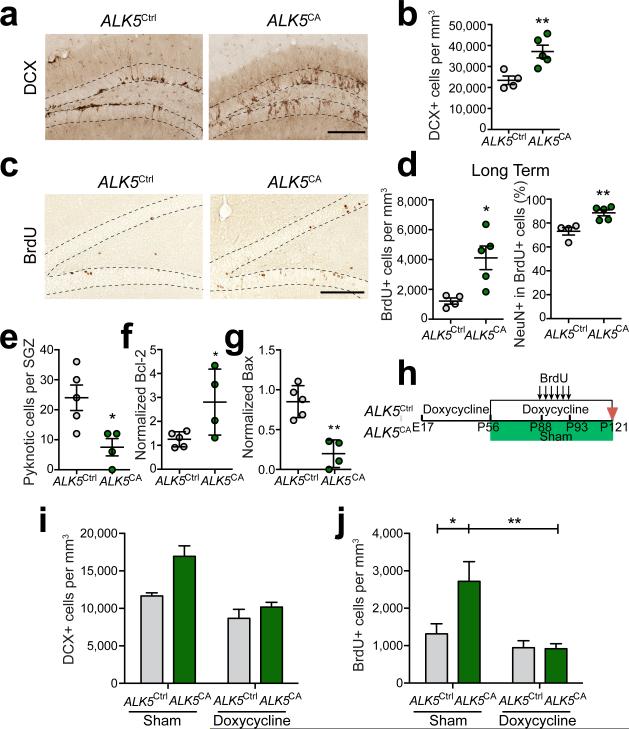Figure 4.
Overexpression of constitutively active ALK5 leads to an increase in the number of newborn neurons in the dentate gyrus. (a,b) Immunohistochemical detection (a) and quantification (b) of DCX labeled neurons in the dentate gyrus (dotted line) from 3-month-old ALK5Ctrl (n = 4) and ALK5CA (n = 5) mice (5 sections per mouse, P = 0.0097). (c,d) Immunohistochemical detection (c) and quantification (d) of BrdU labeled cells (P = 0.0159), as well as quantification of BrdU and NeuN double-labeled newborn neurons (P = 0.0059) in the dentate gyrus (dotted line) from 3-month-old ALK5Ctrl (n = 4) and ALK5CA (n = 5) mice 28 days after BrdU administration. Five sections per mouse. (e) Quantification of the number of pyknotic cells in the SGZ of 3-month-old ALK5Ctrl (n = 5) and ALK5CA (n = 4) mice (10 sections per mouse, P = 0.0189). (f,g) Quantification of Bcl-2 (f) and Bax (g) signal intensity normalized against neuron-specific enolase (NSE) from immunoblots of hippocampal lysates from 3-month-old ALK5Ctrl (n = 5) and ALK5CA (n = 4) mice. (h) Experimental design for the doxycycline treatment of ALK5Ctrl and ALK5CA mice. (i,j) Quantification of DCX (i) and BrdU (j) labeled newborn neurons in the dentate gyrus of 4-month-old ALK5Ctrl and ALK5CA mice before and after treatment with doxycycline (n = 4 mice per group, 5 sections per mouse). In (i), doxycycline × genotype interaction F(1,12) = 3.598, P = 0.0822; doxycycline treatment F(1,12) = 23.82, P = 0.0004; genotype F(1,12) = 11.47, P = 0.0054. In (j), doxycycline × genotype interaction F(1,12) = 5.099, P = 0.0434; doxycycline treatment F(1,12) = 11.73, P = 0.0050; genotype F(1,12) = 4.714, P = 0.0507. Data are presented as mean ± s.e.m. in (b,d,e,i,j), mean ± s.d in (f,g). *P < 0.05, **P < 0.01, Student's t-test in (b,d,e-g). Two-way ANOVA in (i,j), Sidak's post-hoc test in (j). Scale bar, 100 μm.

